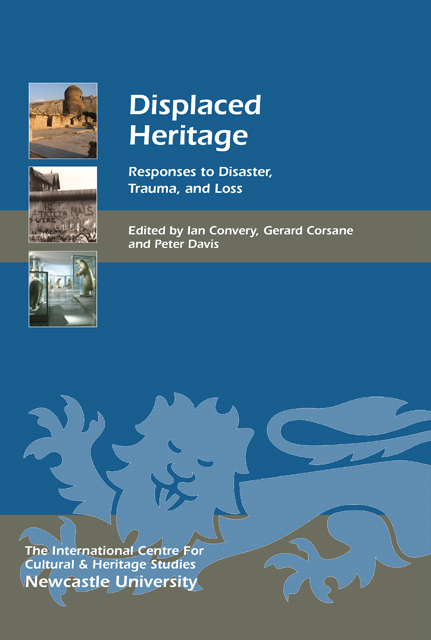Book contents
- Frontmatter
- Contents
- List of Illustrations
- Acknowledgments
- List of Abbreviations
- Preface
- Introduction
- Displaced Heritage: Histories and Tourism
- Displaced Heritage: Trauma, Confinement and Loss
- Displaced Heritage: Lived Realities, Local Experiences
- Displaced Natural Heritage
- Endpiece
- List of Contributors
- Index
- Heritage Matters
4 - Remembering the Queensland Floods: Community Collecting in the Wake of Natural Disaster
Published online by Cambridge University Press: 24 February 2023
- Frontmatter
- Contents
- List of Illustrations
- Acknowledgments
- List of Abbreviations
- Preface
- Introduction
- Displaced Heritage: Histories and Tourism
- Displaced Heritage: Trauma, Confinement and Loss
- Displaced Heritage: Lived Realities, Local Experiences
- Displaced Natural Heritage
- Endpiece
- List of Contributors
- Index
- Heritage Matters
Summary
In January 2011, three-quarters of the Australian state of Queensland was declared a disaster zone, including Brisbane, its capital city, after a series of devastating floods caused widespread destruction. The floodwaters caused over two billion Australian dollars’ worth of damage, wrecking properties and livelihoods, leaving almost 40 people dead or missing and countless thousands with a feeling of trauma or loss. This chapter engages with natural disaster collecting through an exploration of the two community collecting projects undertaken by the State Library of Queensland and the Queensland Museum in the aftermath of the floods. Focusing on the process of collecting, it will discuss the types of objects, images and stories selected, and how factors such as distress, destruction and damage (to people and things) raised issues for collecting institutions. This chapter contributes to an expanding museological discourse on the role of museums and collecting institutions as memoryscapes by offering a unique insight into the relationship between salvaged objects, traumatic memory and natural disaster events.
Disaster Collecting
Disaster collecting has only recently received due attention in museological literature. This may be because museums and collecting institutions have considered disaster collecting to remain outside the bounds of what is normally considered ‘safe collecting’. This, however, is slowly changing as museums are increasingly recognising the importance of collecting salvaged artefacts to remember natural and man-made disasters (cf Williams 2007). In Australia, Dale-Hallett and Higgins (2010) describe how the Museum Victoria established the Victorian Bushfires Collection in the days after the 2009 Victorian bushfires in Australia. They explain how certain factors shaped the development of the collection, including the need to document the tragic events while materials were still available; the lack of collections from previous bushfires; how to respond to offers of donations from people directly affected by the fires; and to think through the role of the museum in community healing. Their work involved actively collecting stories, images and objects that captured the immediate impact of the bushfires, the community response, the aftermath, and the process of recovery and renewal, or what they called ‘rescue collecting’. They also worked closely with a local primary school and collected artworks made by children directly experiencing the impact of the bushfires.
- Type
- Chapter
- Information
- Displaced HeritageResponses to Disaster, Trauma, and Loss, pp. 41 - 50Publisher: Boydell & BrewerPrint publication year: 2014
- 1
- Cited by



